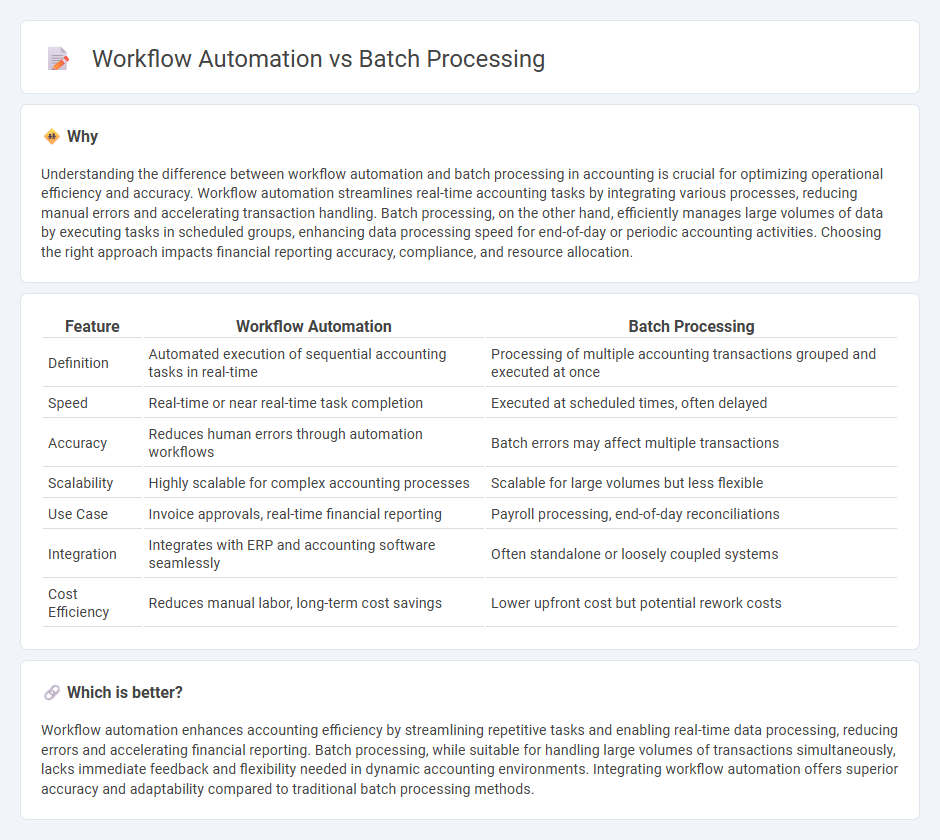
Workflow automation streamlines accounting processes by enabling continuous, real-time data handling and reducing manual intervention, improving accuracy and efficiency. Batch processing, while effective for handling large volumes of transactions at scheduled intervals, may introduce delays and limit immediate data accessibility. Explore how these methods impact financial operations and optimize your accounting system.
Why it is important
Understanding the difference between workflow automation and batch processing in accounting is crucial for optimizing operational efficiency and accuracy. Workflow automation streamlines real-time accounting tasks by integrating various processes, reducing manual errors and accelerating transaction handling. Batch processing, on the other hand, efficiently manages large volumes of data by executing tasks in scheduled groups, enhancing data processing speed for end-of-day or periodic accounting activities. Choosing the right approach impacts financial reporting accuracy, compliance, and resource allocation.
Comparison Table
| Feature | Workflow Automation | Batch Processing |
|---|---|---|
| Definition | Automated execution of sequential accounting tasks in real-time | Processing of multiple accounting transactions grouped and executed at once |
| Speed | Real-time or near real-time task completion | Executed at scheduled times, often delayed |
| Accuracy | Reduces human errors through automation workflows | Batch errors may affect multiple transactions |
| Scalability | Highly scalable for complex accounting processes | Scalable for large volumes but less flexible |
| Use Case | Invoice approvals, real-time financial reporting | Payroll processing, end-of-day reconciliations |
| Integration | Integrates with ERP and accounting software seamlessly | Often standalone or loosely coupled systems |
| Cost Efficiency | Reduces manual labor, long-term cost savings | Lower upfront cost but potential rework costs |
Which is better?
Workflow automation enhances accounting efficiency by streamlining repetitive tasks and enabling real-time data processing, reducing errors and accelerating financial reporting. Batch processing, while suitable for handling large volumes of transactions simultaneously, lacks immediate feedback and flexibility needed in dynamic accounting environments. Integrating workflow automation offers superior accuracy and adaptability compared to traditional batch processing methods.
Connection
Workflow automation in accounting streamlines repetitive tasks by defining a sequence of operations, while batch processing executes large volumes of financial transactions or data entries simultaneously. By integrating batch processing within automated workflows, accounting systems achieve higher efficiency, accuracy, and reduced manual intervention. This connection boosts productivity in managing invoices, payroll, and reconciliations across accounting software platforms.
Key Terms
Transaction Throughput
Batch processing handles large volumes of transactions by executing them in scheduled groups, optimizing resource utilization and system performance during off-peak hours. Workflow automation streamlines individual transaction steps in real-time, enhancing transaction throughput through continuous, incremental processing and reducing latency. Explore the advantages of each approach to identify the optimal solution for maximizing transaction throughput in your operations.
Sequential Processing
Batch processing handles large volumes of data in scheduled, sequential chunks, optimizing resource use and throughput. Workflow automation sequences tasks dynamically, integrating diverse processes across systems to enhance efficiency and reduce manual intervention. Explore how these approaches transform operational workflows in various industries.
Real-Time Updates
Batch processing involves collecting data and executing tasks in scheduled intervals, often leading to delays in reflecting changes. Workflow automation enables real-time updates by continuously monitoring processes and triggering immediate actions, ensuring timely data synchronization across systems. Explore the benefits of integrating workflow automation for enhanced operational efficiency and real-time responsiveness.
Source and External Links
What is Batch Processing? - Batch processing is a computing method where large volumes of data are collected and processed together at scheduled intervals, often automating repetitive tasks without real-time interaction.
An Introduction to Batch Processing - Batch processing involves gathering data over time and processing it in a single operation, enabling comprehensive analysis of historical data, typically using job scheduling tools for automation.
Exploring Batch Processing: Definition, Use Cases, and ... - Batch processing automates the handling of grouped tasks, ideal for scenarios where immediate processing isn't necessary and large datasets can be efficiently managed without constant human oversight.
 dowidth.com
dowidth.com